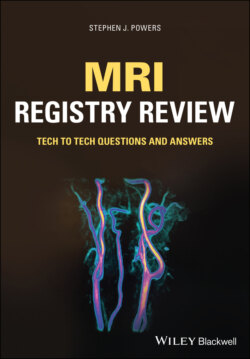Читать книгу MRI Registry Review - Stephen J. Powers - Страница 8
Some Test‐Taking Advice
ОглавлениеI’d like to offer some suggestions, words of advice, and some FYI’s on how to give yourself the best chance to successfully pass the exam.
Sitting for this exam is a big and important next step in your imaging career. Stress will be the word of the day, week, month, or even year while you prep. Chill, it’s not that bad.
My first advice is: Scan baby Scan. You learn a lot by doing. You know more than you think you do. You really do. Review anatomy while you scan. Look for artifacts. Studying while you scan is not just looking at questions during a sequence.
Practice answering questions. Take time a few times a week to answer some questions. Correct them, the ones you got wrong, research the correct answer. This works on your weakness not your strengths.
Try this: Answer 30 questions in 25 minutes. Train to work under some pressure. Not a lot, just some. Navy Seals train under pressure, we’re not Navy seals.
Here is a technique I’ve learned over the years. Explain a concept or topic to somebody. When you verbalize something, you also learn. It makes things make sense. Things start to make more sense when you talk it out. Albert Einstein is credited with saying: “You don’t really understand something unless you can explain it to your Grandmother.” I love that saying, try it and see if it helps.
Now for Test Day
Don’t schedule an appointment time for too early in the morning, if you oversleep, get stuck in traffic, and run late you’ll be even more stressed. It’s difficult to focus when stressed, you’ll make bad choices.
Be 30 minutes early! You may lose your right to sit for the test if you are late.
Get a good night sleep the night before.
Don’t stay up late cramming for the test, you’ll end up getting confused, frustrated, even more stressed and worse yet, less confident.
Have a good breakfast. Don’t be hungry. The brain works on sugar.
Raise your hand to ask bathroom breaks! Not more than 10 minutes long.
You will be photographed, and Palm printed.
Have two valid forms of I.D.: Driver’s license, Passport, or ARRT card.
You can’t bring anything in with you. Not even your pocketbook. They’ll give you a locker. Dress in layers as testing locations vary in temperature.
You’ll need a calculator. One will be issued to you or use the one on the PC desktop.
There is an 18‐minute tutorial about the test. You also need to acknowledge a Non‐Disclosure agreement within two minutes after the tutorial.
Then use the dry erase board!!!
On the dry erase board, jot notes/formulas or mnemonics before you start.
You have 3.5 hours (210 minutes) to do 220 questions. That math is 1:00 minute per question. That may not sound like much but it really is. Many questions you’ll find easy and answer quickly giving more time as you go.
Also don’t be in a rush to leave. Give yourself at least 5+ hours for the whole thing so you don’t have to rush. Answers made in haste well….
Others questions will need some thought, so, DON’T DWELL ON A QUESTION FOR A LONG TIME. You must answer it, mark it as a go back, and continue. You can’t move on to question 22 until you answer question 21.
Practice answering questions at home!!! Practice, Practice, Practice!!
Eliminating Possible Answers
20 of the 220 are pilot questions which don’t count for or against you. You don’t know which ones they are.
There are four answers given for each question. 1 or 2 will probably be out‐right wrong. Eliminate as many as possible to make the right choice.
Look for answers that are ridiculous. If they’re too high/low or just plain can’t be correct, they’re probably wrong. Res Ipsa Loquitur applies.
Look for grammatical clues. If the grammar doesn’t make sense on a fill in the blank or has a wrong syntax, it’s probably not the correct answer.
Let one question answer another. One question may ask what the Gyromagnetic Ratio of Hydrogen is, while another one may have previously stated it while asking another question.
MR Terminology should be generic (not vendor specific). They may make a cross vendor terminology chart available to you. It’s not fair to ask questions using Hitachi terms if you have only scanned on GE or Siemens.
Don’t get crazy trying to know every little aspect or detail of every concept involved in MRI. You are not working on your PhD. The test is designed to test your general knowledge in MRI, anatomy, and patient care.
As for the previous statement, the exam is looking to see if you know basic anatomy, landmarks, and the consequences of your actions when changing scan parameters. For example, what happens to SNR if you decrease the FOV? or, if you increase the TR, what happens to the T1 weighting?
When you are done with the exam, you’ll get a preliminary score. This is not your final official score. You’ll get that in about three weeks.
Raise your hand when you’re done. You can’t just get up and leave. You need to be re‐palm printed before being dismissed.
The next page has a chart taken directly from the ARRT website which shows you the breakdown.
Visit the ARRT website for complete information:
WWW.ARRT.ORG
What to Know
You may ask what do I need to know? I could say, “Know‐it‐All,” but that’s a ridiculous answer and not possible. Key on the major topics.
The next page has a breakdown of each Category and Subcategory. Note where the concentration of the questions is heaviest: Image Production and Procedures.
Patient Care and Safety: Includes Medical‐Legal, terminology. and Ethics.
Image Production: Know the consequences of your actions.
Procedures: Know your Anatomy.
